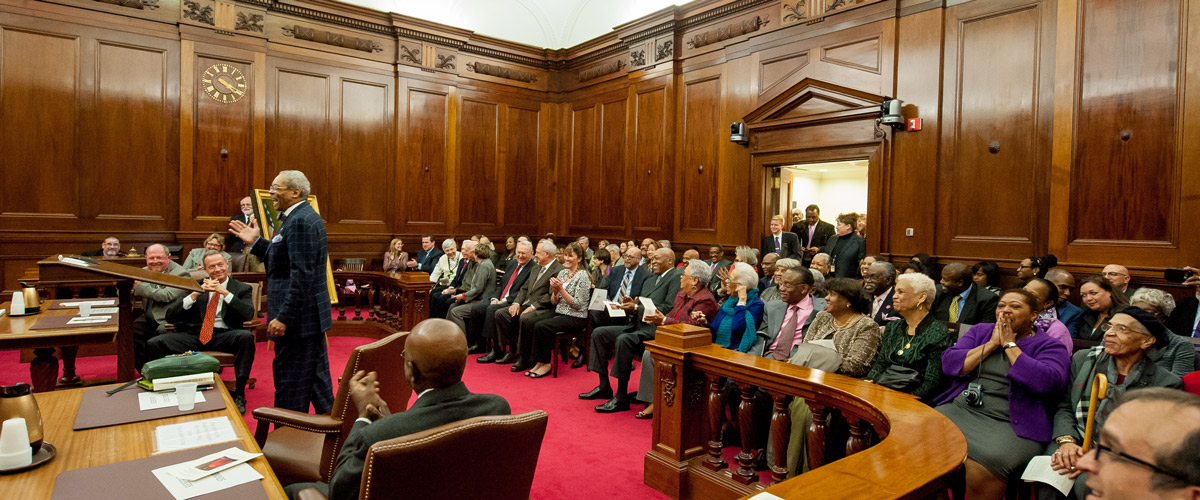Courts Interagency Collaboration Pretrial Services August 11, 2016
The increasing evidence regarding the ineffectiveness of—and harm accrued by—current pretrial practices has prompted support for reform by many national organizations, including those representing the state courts. In 2012, the Conference of State Court Administrators (COSCA) adopted a white paper advocating “that court leaders promote, collaborate toward, and accomplish the adoption of evidence-based assessment of risk in setting pretrial release conditions” and “the presumptive use of non-financial release conditions to the greatest degree consistent with evidence-based assessment of flight risk and threat to public safety and to victims of crime.” The Conference of Chief Justices (CCJ) subsequently endorsed the COSCA paper and joined COSCA’s call to promote system change.
Having built consensus for the need for change, these organizations are now taking steps to act on it. In May, multi-stakeholder teams of chief justices, state court administrators, trial court judges and administrators, pretrial services and probation leaders, attorneys, and county representatives from fourteen states and the territory of Guam met to discuss the legal and empirical research related to effective pretrial justice practices and craft action plans for improving their state/territory’s policies and practices. The meeting was convened by the Western Region Committee of CCJ and COSCA to further their efforts to implement pretrial reform across the country.
Chief Justice Robert J. Torres of Guam opened the proceedings with a recognition of the need for reform and a charge for taking action:
[M]any of the accused defendants are held in jail, even with the presumption of innocence, with substantial harm done to them, their families, their employers, and really the tax payers who have to house them, feed them, medicate them, care for them. . . . I think the rewards we will get at the end of the day are going to be clear and tangible. . . . We’re looking clearly at plans that will help look at a reduced number of confinements, look at a decrease in the number of cases with inappropriate pretrial detention, look at a system that’s based on risk assessment and looking at limited and safe-guarded detention based on assessed risk. So let’s get to work on our reform efforts.
And get to work, they did. Across two intensive days of listening to experts, including other chief justices and state court administrators who have led pretrial reform efforts in their respective states; meeting in teams to identify priorities and challenges to implementation; and, importantly, collaborating on action steps for once they returned home; the teams produced plans that champion the execution of effective legal and evidence-based pretrial practices, such as:
- Using risk assessment to inform pretrial release decision making;
- Supervising pretrial defendants based on their assessed risk level;
- Ensuring defense counsel is present at the earliest hearing in which a pretrial release decision is made;
- Identifying and collecting data on jail populations, pretrial release decisions, supervision, and outcomes to inform pretrial practices and assess their effectiveness;
- Abolishing fixed money bail schedules;
- Adopting new legislation and/or court rules to implement effective pretrial practices;
- Ensuring consistent pretrial practices across a state’s counties; and
- Implementing systems to remind defendants on pretrial release about upcoming court dates to avoid failure to appear.
The teams realized the challenges embedded in turning these priorities into realities, but they committed to one another to see their plans through to fruition, inspired by the words of Chief Justice Charles W. Daniels about New Mexico’s reform efforts:
What we found out is that it takes a lot of education to overcome this culture and these misunderstandings, and it’s a never-ending job. It takes strong leadership by the Supreme Court. It certainly has in this state. Just putting words on paper and walking away clearly is not going to change this system. It takes a lot of education of the public. But, on the whole, it’s worth the effort. As I said earlier today, it’s probably the most significant improvement in our justice system that I will have seen in my time on the court, and I suspect I will never change my mind about that no matter how many more years I serve.
For more information about COSCA and CCJ’s efforts to improve pretrial practices, see COSCA’s policy paper on pretrial release and CCJ’s endorsement of the paper’s recommendations. For more information on state pretrial justice reform efforts, see the NCSC’s Pretrial Justice Center for Courts and Pretrial Justice Briefs.


